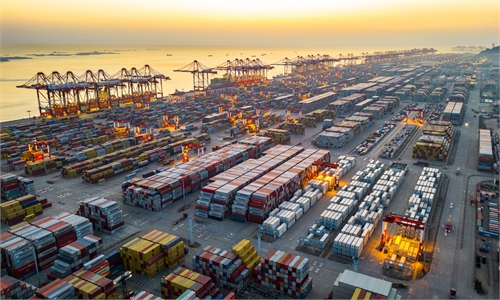Over 10 Chinese provinces record faster than national average GDP growth, mirroring economic vitality in different fronts

Aerial photo taken on April 4, 2020 shows the Atlantis resort in Sanya, south China's Hainan Province. Photo: Xinhua
More than 17 Chinese provinces, municipalities and autonomous regions have released their first-quarter GDP growth data, with over 10 recording a rosy growth rate that is faster than the national average of 4.5 percent, a trend which observers said mirrors the vitality of the world's second-largest economy across different fronts and a fast-track recovery that has already shaken off the epidemic fallout.
A total of 13 provinces - including Northeast China's Jilin, South China's Hainan, North China's Tianjin Municipality and Shanxi, as well as East China's Zhejiang - of the 17 provinces that have already released first-quarter economic data, have recorded GDP growth rates of above 4.5 percent.
Of these, Jilin leads with an 8.2 percent year-on-year GDP expansion. The province's economic drive is particularly visible in fixed-asset investment, which jumped 28.1 percent year-on-year in the first quarter, compared with a national average of 5.1 percent.
In the first three months of 2022, Jilin's economy contracted 7.9 percent due to disruptions caused by the epidemic.
Observers said Jilin's deep rebound is strong proof of how the Chinese economy has embarked on a stronger than expected recovery in the first quarter, with potential in different areas set to be fully realized throughout the year.
Zhejiang, known as China's manufacturing center and foreign trade hub, saw a GDP growth of 4.9 percent in the first three months. The city of Ningbo, where the Ningbo-Zhoushan port, the world's largest port in terms of handling capacity, is based, saw an export growth of 18 percent year-on-year in March.
The economy of Hainan and Southwest China's Yunnan provinces, two of the country's hottest tourist destinations, expanded by 6.8 percent and 4.8 percent in the first quarter, respectively. Amid a tourism boom, the growth was led by an uptick in the tertiary service industry, with the value-added of Hainan's tertiary industry gaining 7.7 percent and that of Yunnan soaring 5.6 percent.
Shanxi's GDP expanded 5 percent year-on-year in the first quarter. The province's coal output grew 8.9 percent to 335 million tons in the first three months, setting a quarterly new high amid mushrooming energy demand. Coal production also ranked first in the country.
In terms of economic volume, Zhejiang, Southwest China's Sichuan, Central China's Hubei and Hunan, and Shanghai all achieved an economic output of over 1 trillion yuan ($145.1 billion).
"It is also worth noting that China's central, western, and northeastern regions have shown a robust recovery trend, which also speaks volumes of an industrial upgrade and a more balanced economic development landscape with reduced regional gaps," Tian Yun, former vice director of the Beijing Economic Operation Association, told the Global Times on Saturday.
The sizzling growth engines from different provinces offer a comprehensive picture of the green shoots of China's economy. Looking ahead, analysts predict that on the back of strengthening internal momentum and stepped-up policies, GDP growth will notably speed up in the second quarter, and the full-year GDP target will probably be higher than the annual 5 percent target.
"The economy will likely further rebound to as high as 8 percent between April and June given a lower base from the same quarter last year," Chen Fengying, an economist and former director of the Institute of World Economic Studies at the China Institutes of Contemporary International Relations, told the Global Times.
Tian said that the central and western regions are poised to make more contributions to the incremental economic volume, which would also have a great effect on China's future economic potential in the coming years.
Ding Shuang, chief economist of Greater China and North Asia at Standard Chartered Bank, told the Global Times that there could be wider room for the recovery of consumption this year after Chinese residents roll down the saving rate.
It is estimated that Chinese individuals' savings deposits increased by 18 trillion yuan last year, of which excessive saving for preventive purposes could hit 5 trillion yuan.
To further gauge the soundness of the economy, observers also suggested keeping an eye on the performance of Shanghai, Hainan and Guangdong for the rest of the year, as those cities and regions were hit hardest by the epidemic last year.
China's GDP in the first three months reached 28.5 trillion yuan, up 4.5 percent year-on-year, or an increase of 2.2 percent compared with the fourth quarter of 2022, according to data released by the National Bureau of Statistics on Tuesday.



